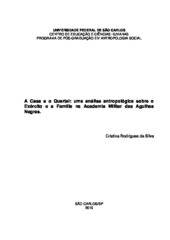| dc.contributor.author | Silva, Cristina Rodrigues da | |
| dc.date.accessioned | 2016-06-02T19:00:26Z | |
| dc.date.available | 2012-10-04 | |
| dc.date.available | 2016-06-02T19:00:26Z | |
| dc.date.issued | 2010-03-04 | |
| dc.identifier.citation | SILVA, Cristina Rodrigues da. A casa e o quartel : uma análise antropológica sobre o exército e a família na Academia Militar das Agulhas Negras. 2010. 178 f. Dissertação (Mestrado em Ciências Humanas) - Universidade Federal de São Carlos, São Carlos, 2010. | por |
| dc.identifier.uri | https://repositorio.ufscar.br/handle/ufscar/213 | |
| dc.description.abstract | The dissertation aims to accomplish an anthropological analysis on the family of the militaries. It seeks to understand the peculiar relationship between Army and Family, in which the very idea of Military Family indicates sometimes the military contingent of the institution; or the family in its private meaning (spouse and children) and sometimes all these elements together. An ethnographic research was carried out in Aman (Military Academy of the Agulhas Negras an institution of the Brazilian Army) and in its respective village between 2007 and 2008, where interviews were performed with couples that are configured in three different ways of family: couples in which only the husband is a military; couples in which both husband and wife are militaries and couples in which only the wife is a military. It is shown that the life of the family is linked to the military occupation of the spouse, in such a way that there is an expected military family model , being operated (to some extent) by the Army and that reflects, in particular, the case of the families in which only the husband is a military. The other familial forms present some tensions to this native model, where the main disruption occurs on the configuration of the woman s gender. Still, there seems to be "adjustments" to the native model and these new arrangements remain tied to the military life. It investigates cases of formal regulation, exchange relationships (principles of unity and solidarity among the families), social constraints (surveillance and gossip), and finally the construction of an entire symbolic apparatus, in which the Army maps roles, obligations and benefits of the officers families. Thus, it is apparent that the Army embraces the families. However, it is also pointed out that there is a double movement between home (here understood as the family of the military - spouses and children relationship, and close relatives) and barracks (relations of the military bases). Not only the barracks determines the relations in the house, but also the house determines the relations in the barracks. | eng |
| dc.description.sponsorship | Universidade Federal de Minas Gerais | |
| dc.format | application/pdf | por |
| dc.language | por | por |
| dc.publisher | Universidade Federal de São Carlos | por |
| dc.rights | Acesso Aberto | por |
| dc.subject | Família | por |
| dc.subject | Militares | por |
| dc.subject | Gênero | por |
| dc.subject | Antropologia | por |
| dc.subject | Militaries | eng |
| dc.subject | Family | eng |
| dc.subject | Gender | eng |
| dc.subject | Anthropology | eng |
| dc.title | A casa e o quartel: uma análise antropológica sobre o exército e a família na Academia Militar das Agulhas Negras | por |
| dc.type | Dissertação | por |
| dc.contributor.advisor1 | Leirner, Piero de Camargo | |
| dc.contributor.advisor1Lattes | http://genos.cnpq.br:12010/dwlattes/owa/prc_imp_cv_int?f_cod=K4723673U9 | por |
| dc.description.resumo | A dissertação tem como objetivo uma análise antropológica sobre a família do militar. Busca-se compreender a peculiar relação entre Exército e Família, em que a própria idéia de Família Militar indica ora o contingente militar da instituição; ora a família no seu sentido privado (cônjuge e filhos/as) e ora todos estes elementos juntos. Foi realizada uma pesquisa etnográfica na Aman (Academia Militar das Agulhas Negras instituição do Exército brasileiro) e em sua respectiva vila entre 2007 e 2008, onde foram entrevistados casais que se configuram em três formas de família: casais em que só o marido é militar; casais em que ambos os cônjuges são militares e casais em que só a esposa é militar. Mostra-se que a vida dos familiares está vinculada à profissão do cônjuge militar, de tal modo que se verifica um modelo de família militar esperado e sendo operado (em alguma medida) pelo Exército e que reflete, em particular, o caso das famílias em que só o marido é militar. As demais formas familiais apresentam algumas tensões a esse modelo nativo, onde a principal fissura se dá na configuração de gênero da mulher. Mesmo assim, parece haver adaptações ao modelo nativo e esses novos arranjos permanecem atrelados à vida militar. Investiga-se processos de regulação formal, relações de troca (princípios de união e solidariedade entre as famílias), constrangimentos sociais (vigilância e fofoca) e, enfim, a construção de todo um aparato simbólico, na qual o Exército mapeia papéis, obrigações e benefícios das famílias dos oficiais. Logo, mostra-se que o Exército engloba as famílias. No entanto, é apontado também, que há um duplo movimento entre casa (aqui entendida como a família do militar relação cônjuge e filhos/as, e parentes próximos) e caserna (relações do quartel). Não só a caserna determina relações na casa, como a casa determina relações na caserna. | por |
| dc.publisher.country | BR | por |
| dc.publisher.initials | UFSCar | por |
| dc.publisher.program | Programa de Pós-Graduação em Antropologia Social - PPGAS | por |
| dc.subject.cnpq | CIENCIAS HUMANAS::ANTROPOLOGIA | por |
| dc.contributor.authorlattes | http://lattes.cnpq.br/5036907198351191 | por |
